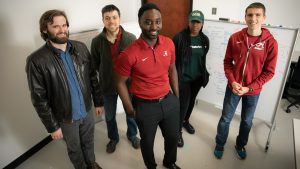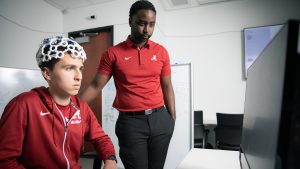
TUSCALOOSA, Ala. — A University of Alabama computer science professor has received a grant to better understand how K-12 students in the Alabama Black Belt perceive human-computer interaction.
Dr. Chris Crawford, UA assistant professor of computer science, was awarded an approximate $276,000 National Science Foundation grant to develop technology that allows children to get hands-on experiences building neurofeedback programs, a type of biofeedback application that uses near real-time visualizations of brain activity to teach self-regulation.
“All of the previous popular approaches involve using traditional input modalities like a game controller, keyboard or a mouse,” Crawford said. “So, one of the things that we don’t understand is what kinds of observations will we have when kids are presented with this novel input modality, which is basically their cognitive commands or their thoughts, and how does that influence the way they gain computational thinking skills.”
Crawford’s focus on physiological computing, any closed-loop technological system that incorporates physiological data, dates back to his time in graduate school when the increase of consumer grade, or home use, technologies sparked interest in non-critical applications to engage students.
Previously, Crawford worked on a project involving brain-controlled drone racing, which helped influence the idea for his current research. During that project, Crawford and his team connected electroencephalogram, or EEG, devices to drones, and people raced each other with their brains as opposed to controllers.
“The motivation for the initial reason to look at neurophysiological technology, and the way I am looking at it, is because once we did this, it went viral,” Crawford said. “A lot of people started emailing me saying ‘how do we build these types of systems?’”
This new grant will help Crawford research building computer science education and non-critical applications based on how students in the Alabama Black Belt in K-12 relate to this technology in an educational and practical way.
“This is the first time we are starting from scratch to see exactly how to best design this type of technology for people who may not be very experienced in computer science or in neuroscience techniques in general,” Crawford said.

The co-principal investigator on the grant is Dr. Andre Denham, associate professor of instructional technology for UA’s College of Education. Denham will ensure the technology addresses the needs found during the preliminary research.
The process will focus on understanding how people learn ways to interface, or exchange information, with new physiological systems. This analysis will set the fundamental groundwork for future research on physiological computing.
“I have ideas of what I expect, but it’s so unexplored,” Crawford said. “Who knows what we will come up with in this research? It was great to get the award, but to be awarded to do something this exploratory is a great feeling.”
The similar interests of the Education and Human Resources Division of NSF led Crawford to apply for the grant. Crawford said most of the research in this field focuses on building end-user technology, which results in applications computer scientists think people want rather than the types of applications people actually need.
“It’s understanding the learning process that crosses the bridge of CS education and neuroscience where the students are not just the users of the technology, they actually have a hand-in-hand role in designing and implementing the technology itself,” Crawford said. “What we hope is that this then leads to more novel types of ways to use the technology because you have a broader population of people actually looking at using it because they understand how it works.”
Contact
Alana Norris and Gillian Castro, engineering communications, 205/348-6444, anorris@eng.ua.edu
Source
Dr. Chris Crawford, crawford@cs.ua.edu
